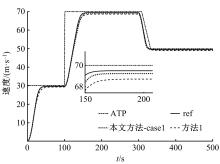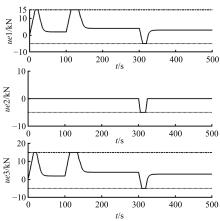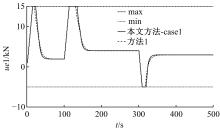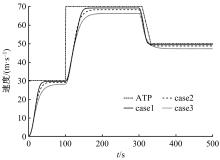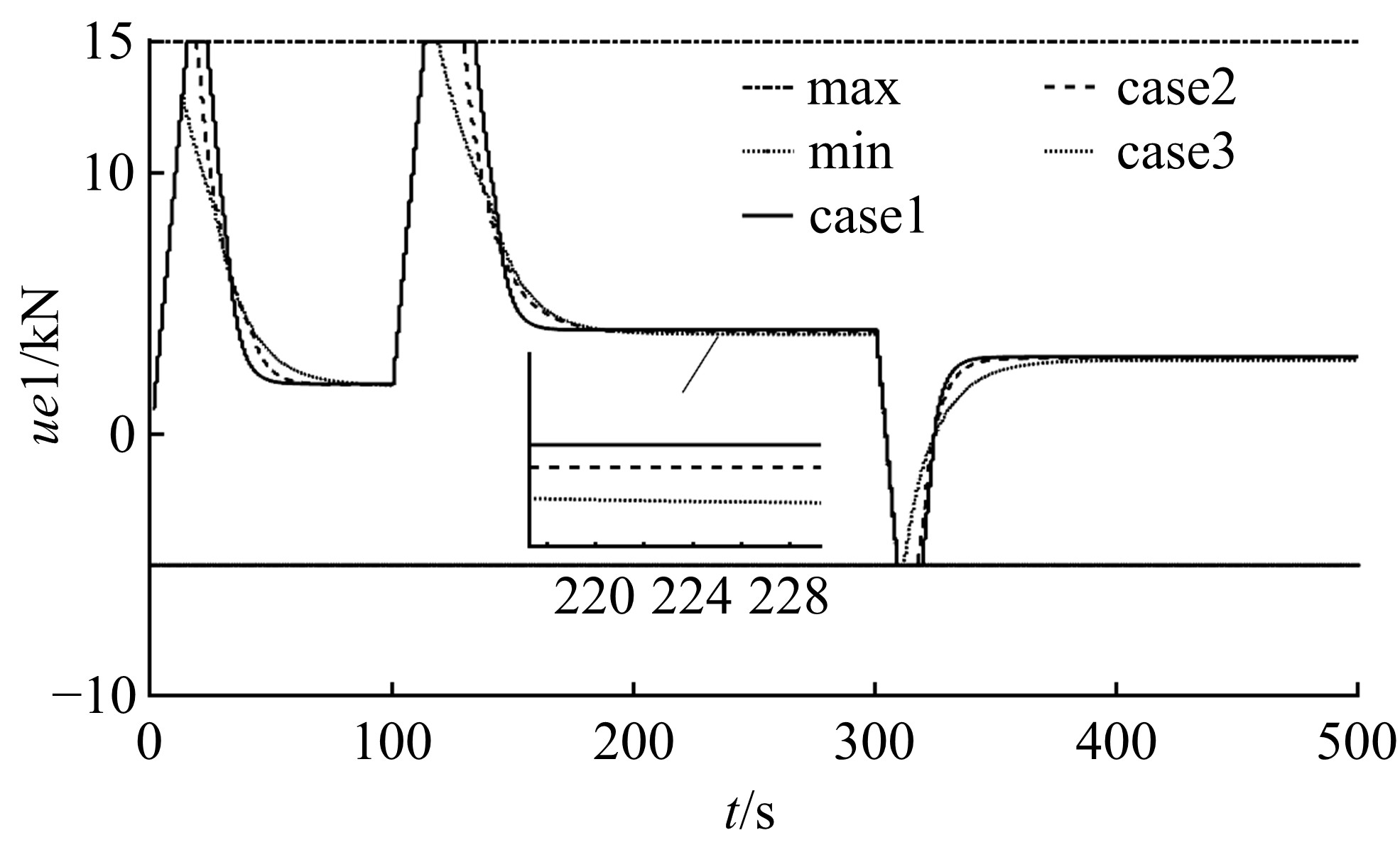吉林大学学报(工学版) ›› 2020, Vol. 50 ›› Issue (5): 1913-1922.doi: 10.13229/j.cnki.jdxbgxb20190609
• 通信与控制工程 • 上一篇
基于多质点模型的列车自动驾驶非线性模型预测控制
- 1.北京交通大学 电子信息工程学院, 北京 100044
2.中国铁道科学研究院 通信信号研究所, 北京 100081
Nonlinear model predictive control for automatic train operation based on multi⁃point model
Chao JIA1( ),Hong-ze XU1,Long-sheng WANG2
),Hong-ze XU1,Long-sheng WANG2
- 1.School of Electronic and Information Engineering,Beijing Jiaotong University,Beijing 100044,China
2.Signal & Communication Research Institute,China Academy of Railway Sciences,Beijing 100081,China
摘要:
研究了多目标优化和多运行约束条件下的列车自动驾驶系统控制器设计问题。在建立非线性多质点模型的基础上,提出了满足列车准时性、节能及乘坐舒适度的列车自动驾驶非线性模型预测控制算法,并给出了算法的可行性及闭环系统稳定性的理论证明。数值仿真验证了本文算法的有效性,仿真结果表明:列车在满足运行约束的条件下,与线性模型预测控制算法相比,本文算法控制效果更好,误差更低。
中图分类号:
- U284.48
| 1 | Dong H, Ning B, Cai B, et al. Automatic train control system development and simulation for high-speed railways[J]. IEEE Circuits and Systems Magazine, 2010, 10(2): 6-18. |
| 2 | 郭红戈, 谢克明. 动车组列车制动系统的Hammerstein模型及其参数辨识方法[J]. 铁道学报, 2014, 36(4): 48-53. |
| Guo Hong-ge, Xie Ke-ming. Hammerstein model and parameters identification of EMU braking system[J]. Journal of the China Railway Society, 2014, 36(4): 48-53. | |
| 3 | 唐涛, 黄良骥. 列车自动驾驶系统控制算法综述[J]. 铁道学报, 2003, 25(2): 98-102. |
| Tang Tao, Huang Liang-ji. A survey of control algorithm for automatic train operation[J]. Journal of the China Railway Society, 2003, 25(2): 98-102. | |
| 4 | 石卫师. 基于无模型自适应控制的城轨列车自动驾驶研究[J]. 铁道学报, 2016, 38(3): 72-77. |
| Shi Wei-shi. Research on automatic train operation based on model-free adaptive control[J]. Journal of the China Railway Society, 2016, 38(3): 72-77. | |
| 5 | Oshima H, Yasunobu S, Sekino S I. Automatic train operation system based on predictive fuzzy control[C]∥Proceedings of the International Workshop on Artificial Intelligence for Industrial Applications, Hitachi, Japan, 1988: 485-489. |
| 6 | 余进, 钱清泉, 何正友. 两级模糊神经网络在高速列车ATO系统中的应用研究[J]. 铁道学报, 2008, 30(5): 52-56. |
| Yu Jin, Qian Qing-quan, He Zheng-you. Research on application of two-degree fuzzy neural network in ATO of high speed train[J]. Journal of the China Railway Society, 2008, 30(5): 52-56. | |
| 7 | Sun H Q, Hou Z S, Tang T. An iterative learning approach for train trajectory tracking control[C]∥Proceedings of the International Federation of Automatic Control, Milano, Italy, 2011: 14916-14921. |
| 8 | 罗恒钰, 徐洪泽. 基于参考模型的ATO自适应控制算法研究[J]. 铁道学报, 2013, 35(7): 68-73. |
| Luo Heng-yu, Xu Hong-ze. Study on model reference adaptive control of ATO systems[J]. Journal of the China Railway Society, 2013, 35(7): 68-73. | |
| 9 | 冷勇林, 陈德旺, 阴佳腾. 基于专家系统及在线调整的列车智能驾驶算法[J]. 铁道学报, 2014, 36(2): 62-68. |
| Leng Yong-lin, Chen De-wang, Yin Jia-teng. An intelligent train operation(ITO) algorithm based on expert system and online adjustment[J]. Journal of the China Railway Society, 2014, 36(2): 62-68. | |
| 10 | 王龙生, 徐洪泽, 张梦楠, 等. 基于混合系统模型预测控制的列车自动驾驶策略[J]. 铁道学报, 2015, 37(12): 53-60. |
| Wang Long-sheng, Xu Hong-ze, Zhang Meng-nan, et al. Hybrid model predictive control application to automatic train operation[J]. Journal of the China Railway Society, 2015, 37(12): 53-60. | |
| 11 | 王义惠, 罗仁士, 于振宇, 等. 考虑列车ATP限速的ATO控制算法研究[J]. 铁道学报, 2012, 34(5): 59-64. |
| Wang Yi-hui, Luo Ren-shi, Yu Zhen-yu, et al. Study on ATO control algorithm with consideration of ATP speed limits[J]. Journal of the China Railway Society, 2012, 34(5): 59-64. | |
| 12 | Zhang L J, Zhuan X T. Optimal operation of heavy-haul trains equipped with electronically controlled pneumatic brake systems using model predictive control methodology[J]. IEEE Transactions on Control Systems Technology, 2013, 22(1): 13-22. |
| 13 | Zhang L, Zhuan X. Development of an optimal operation approach in the MPC framework for heavy-haul trains[J]. IEEE Transactions on Intelligent Transportation Systems, 2014, 16(3): 1391-1400. |
| 14 | Zhuan X, Xia X. Speed regulation with measured output feedback in the control of heavy haul trains[J]. Automatica, 2008, 44(1): 242-247. |
| 15 | 杨辉, 张坤鹏, 王昕, 等. 高速列车多模型广义预测控制方法[J]. 铁道学报, 2011, 33(8): 80-87. |
| Yang Hui, Zhang Kun-peng, Wang Xin, et al. Generalized multiple-model predictive control method of high-speed train[J]. Journal of the China Railway Society, 2011, 33(8): 80-87. | |
| 16 | 杨罡, 刘光明, 喻乐. 高速列车运行过程的非线性预测控制[J]. 铁道学报, 2013, 35(8): 16-21. |
| Yang Gang, Liu Guang-ming, Yu Le. Nonlinear predictive control of operation process of high-speed train[J]. Journal of the China Railway Society, 2013, 35(8): 16-21. | |
| 17 | 姚拴宝, 郭迪龙, 杨国伟, 等. 高速列车气动阻力分布特性研究[J]. 铁道学报, 2012, 34(7): 18-23. |
| Yao Shuan-bao, Guo Di-long, Yang Guo-wei, et al. Distribution of high-speed train aerodynamic drag[J]. Journal of the China Railway Society, 2012, 34(7): 18-23. | |
| 18 | Yang C D, Sun Y P. Mixed H2/H∞ cruise controller design for high speed train[J]. International Journal of Control, 2001, 74(9): 905-920. |
| 19 | Besselmann T, Lofberg J, Morari M. Explicit MPC for LPV systems: stability and optimality[J]. IEEE Transactions on Automatic Control, 2012, 57(9): 2322-2332. |
| [1] | 曲大义,贾彦峰,刘冬梅,杨晶茹,王五林. 考虑多特性因素的路网交叉口群动态划分方法[J]. 吉林大学学报(工学版), 2019, 49(5): 1478-1483. |
| [2] | 柳润东,毛军,郗艳红,张宏宇,彭飞. 横风下高速列车会车压力波对风障的气动冲击[J]. 吉林大学学报(工学版), 2019, 49(4): 1054-1062. |
| [3] | 吴骅跃,段里仁. 基于RGB熵和改进区域生长的非结构化道路识别方法[J]. 吉林大学学报(工学版), 2019, 49(3): 727-735. |
| [4] | 陶涛,徐洪泽. 高速列车浸入与不变自适应容错控制方法[J]. 吉林大学学报(工学版), 2015, 45(2): 554-561. |
| [5] | 石屹然, 田彦涛, 史红伟, 张立. 基于Modified Volterra模型的SI发动机空燃比非线性模型预测控制[J]. 吉林大学学报(工学版), 2014, 44(2): 538-547. |
| [6] | 于树友, 陈虹, 赵海艳. 非线性离散时间系统的准无限时域NMPC[J]. 吉林大学学报(工学版), 2009, 39(04): 1002-1006. |
| [7] | 陈 强, 李 江, 吴 想, 闫松申. 轮胎印痕识别算法及实例分析[J]. 吉林大学学报(工学版), 2005, 35(01): 39-0043. |
|
||


